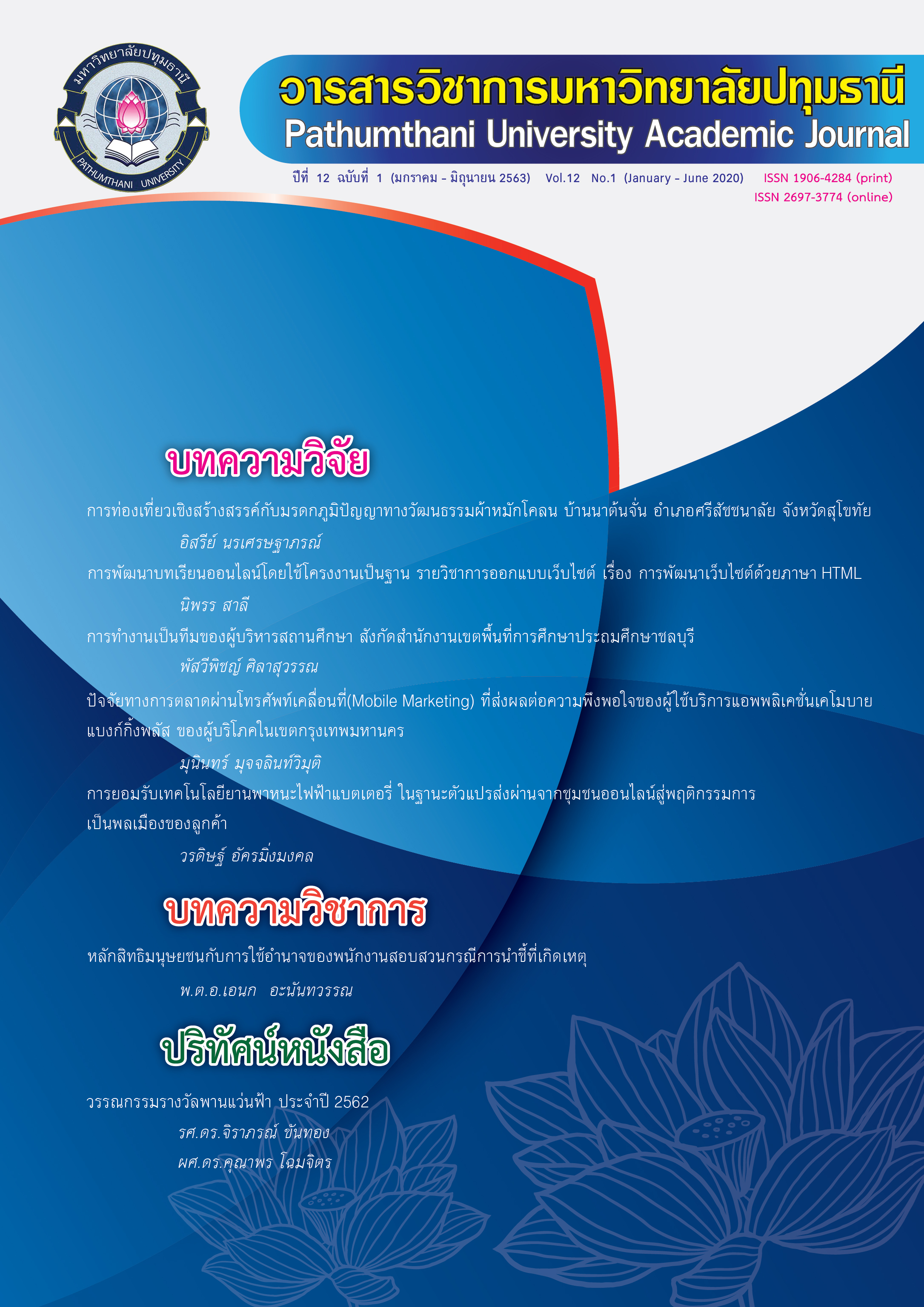BUSINESS MODEL OF INTERNET OF THINGS IN BANGKOK METROPOLITAN SMART CITY
Keywords:
Business Model, Internet of Things, Bangkok Metropolitan Smart CityAbstract
This research were quantitative method aim to studies 1) using behavior on Internet of Things 2) factors leading to business model of Internet of Things in Bangkok Metropolitan Administration Smart City 3) relative between using behavior on Internet of Things and factors leading to business model of Internet of Things in Bangkok Metropolitan Administration Smart City 4) business model of Internet of Things in Bangkok Metropolitan Administration Smart City, by accidental sampling random 385 respondents. Questionnaire was the tool to collecting data with validity coefficient .87 and reliability coefficient .82. The analysis was conducted by computer software, statistical treatments by program computer namely: frequency, percentage, mean, standard deviation, ranking, Pearson correlation, and multiple regression analysis Stepwise at significant statistics level at .05 researchers found that 1.Finding indicated that overall and every area of using behavior onInternet of Things were at moderate level. However, the raking by mean were popular activity using on internet area ( =3.24) and media consume data on Internet of Things area (
=2.92) respectively. 2.Finding indicated that overall and every area of factors leading tobusiness model of Internet of Things in Bangkok Metropolitan Administration Smart City significant were at high level, raking by mean first smart government area (
= 3.85), smart living (
=3.82), smart environment (
=3.70), smart economy (
= 3.60), smart citizen (
=3.53), and smart mobility area (
=3.45) respectively 3.There was at low relationship level positive direction between overall area of using behavior on Internet of Things and factors leading to business operation model of Internet of Things in Bangkok Metropolitan Administration Smart City Business model of Internet of Things in Bangkok Metropolitan Administration Smart City = .62 smart living such as Develop a wristband for health and fitness and sensors electrocardiogram (ECG). As well as living in the home such as sensors fire detection/fire alarm and control of electrical equipment in the home (Lighting, TV, Air conditioning) etc. +.53 smart economy such as Develop an intelligent travel guide system through a cabinet or board that integrates with Internet of Things. To provide tourist information to tourists. This concept can also be used to introduce products in stores or department stores as well. Not only will the system present information Can also store user behavior and behavior analysis. To use in marketing planning. In the agricultural sector can be used to control and analyze the cultivation etc. +.42 smart citizen such as Develop an innovation center filled with smart gadgets. To use the Innovation Center This concept can be extended to the Education. Take Internet of Thinks to school or classroom to check your name and send it to your teacher or parent. Libraries in schools or public libraries used in conjunction with smartphone apps to search for books etc. +.348 smart environment such as Develop flood monitoring equipment when the rainfall exceeds the limit, the system will send a notification to the officer. Oxygen River Level Monitoring and Carbon Dioxide Detection on the Road This will help to collect data for use in analyzing sustainable solutions. Environmental care is not just about measuring the environment, but also about keeping the environment in good condition. The use of the Internet of Things to help water the tree along the shoulder or the park by measuring the heat to water the trees, adding moisture to the shoulder or park. Or can be ordered with the application on the smartphone etc. +.21 smart mobility such as Develop an alarm system when an accident sends a signal to the family police and related agencies are displayed on the smartphone application. Or the warning of the components of the car such as tires, suspension, drive system real time status is provided to the driver. And voice commands that will greatly enhance the convenience as well. Cold, open music to answer the phone. Including the command to drive automobiles (without drivers) etc.
References
ณัฐศักดิ์ วรวิทยานนท์. (2556). ทัศนคติของผู้บริโภคที่มีต่อธุรกิจขายสินค้าและบริการออนไลน์. การค้นคว้าอิสระปริญญาบริหารธุรกิจมหาบัณฑิต สาขาวิชาการบริหารธุรกิจ.มหาวิทยาลัยเชียงใหม่.
วิวัฒน์ มีสุวรรณ์. (2559). อินเทอร์เน็ตเพื่อสรรพสิ่ง (Internet of Things) กับการศึกษา Internet of Things on Education. คณะศึกษาศาสตร์ มหาวิทยาลัยนเรศวร.
เอกชัย สุมาลี และคณะ. (2560). โครงการวิจัยเชิงนโยบายเพื่อเสนอแนะแนวทางการยกระดับ อุตสาหกรรมซอฟต์แวร์และอิเล็กทรอนิกส์ภายใต้กรอบของ Internet of Things และ Smart City. สถาบันเทคโนโลยีพระจอมเกล้าเจ้าคุณทหารลาดกระบัง.
Downloads
Published
How to Cite
Issue
Section
License
บทความที่ได้รับการตีพิมพ์เป็นลิขสิทธิ์ของวารสารมหาวิทยาลัยปทุมธานี
ข้อความที่ปรากฎในบทความแต่ละเรื่อง เป็นความคิดเห็นส่วนตัวของผู้เขียน กองบรรณาธิการไม่จำเป็นต้องเห็นด้วยเสมอไป และไม่มีส่วนรับผิดชอบใด ๆ ถือเป็นความรับผิดชอบของผู้เขียนแต่เพียงผู้เดียว



